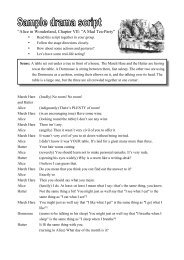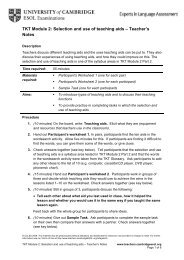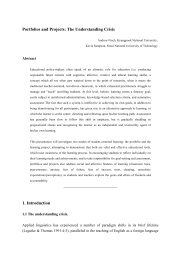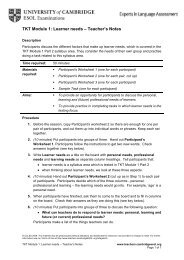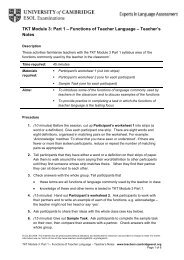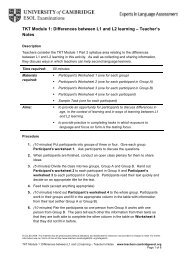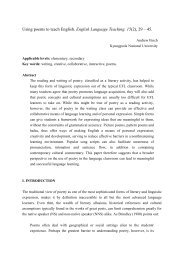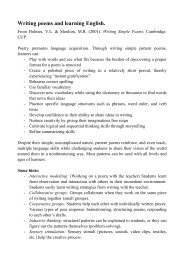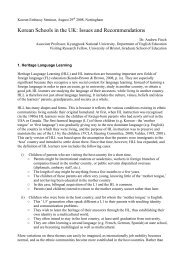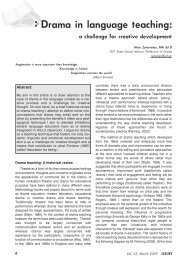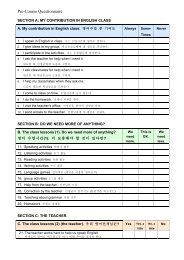Common sequences in lessons - Finchpark
Common sequences in lessons - Finchpark
Common sequences in lessons - Finchpark
Create successful ePaper yourself
Turn your PDF publications into a flip-book with our unique Google optimized e-Paper software.
TKT Module 2: <strong>Common</strong> <strong>sequences</strong> <strong>in</strong> <strong>lessons</strong> – Teacher’s Notes<br />
Description<br />
In this activity, participants explore common <strong>sequences</strong> <strong>in</strong> <strong>lessons</strong> through different<br />
sequenc<strong>in</strong>g activities. They consider <strong>sequences</strong> typical to different lesson types and<br />
complete a sample task. <strong>Common</strong> sequenc<strong>in</strong>g <strong>in</strong> <strong>lessons</strong> is tested <strong>in</strong> TKT Module 2 Part 1.<br />
Time required:<br />
Materials<br />
required:<br />
50 m<strong>in</strong>utes<br />
• Participant’s Worksheet 1 (cut <strong>in</strong>to boxes, one box per participant)<br />
• Participant’s Worksheet 2 (cut <strong>in</strong>to strips, one set for each pair)<br />
• Participant’s Worksheet 3 (one for each participant)<br />
• Sample Task (one for each participant)<br />
Aims: • To familiarise participants with common sequenc<strong>in</strong>g <strong>in</strong> <strong>lessons</strong><br />
• To provide practice <strong>in</strong> complet<strong>in</strong>g tasks <strong>in</strong> which sequenc<strong>in</strong>g lesson<br />
stages is the test<strong>in</strong>g focus.<br />
Procedure<br />
1. Before the session, cut up Participant’s worksheet 1 <strong>in</strong>to separate boxes. Each box<br />
is a stage of a lesson, and each row of three boxes forms one lesson sequence.<br />
There are six lesson <strong>sequences</strong> <strong>in</strong> total. Repeat or reduce the number of boxes<br />
accord<strong>in</strong>g to the size of your group, ensur<strong>in</strong>g each lesson sequence is complete. If<br />
the number of participants is not divisible by 3, repeat one or two of the stages from<br />
one lesson sequence.<br />
Cut up Participant’s worksheet 2 <strong>in</strong>to strips so there is one set of strips for each<br />
pair of participants.<br />
2. (10 m<strong>in</strong>utes) Give each participant one stage of a lesson from Participant’s<br />
worksheet 1. Expla<strong>in</strong> that the pieces of paper are the stages of different lesson<br />
<strong>sequences</strong> and that there are three stages for each lesson sequence. Participants<br />
walk around say<strong>in</strong>g their stages to other participants until they f<strong>in</strong>d two other people<br />
with stages from the same lesson sequence. They should then sit together <strong>in</strong> groups<br />
of three, put their stages <strong>in</strong> order and discuss what would come before and what<br />
would come after the three stages.<br />
3. Feed back with the whole group so that participants can share their <strong>sequences</strong> (see<br />
key below). Ask participants to th<strong>in</strong>k about what they had to do <strong>in</strong> the activity<br />
(sequence stages of <strong>lessons</strong>). Tell participants that ‘sequenc<strong>in</strong>g stages of <strong>lessons</strong>’ is<br />
a syllabus area tested <strong>in</strong> TKT Module 2 Part 1.<br />
4. (10 m<strong>in</strong>utes) Hand out Participant’s worksheet 2, cut <strong>in</strong>to strips, to each pair. In<br />
pairs, participants look at the stages of the lesson on the strips and arrange them <strong>in</strong>to<br />
a logical sequence. Check answers together (see key below).<br />
© UCLES 2009. This material may be photocopied (without alteration) and distributed for classroom use provided no charge is made. For further<br />
<strong>in</strong>formation see our Terms of Use at http://www.teachers.cambridgeESOL.org/ts/legal<strong>in</strong>fo<br />
TKT Module 2: <strong>Common</strong> <strong>sequences</strong> <strong>in</strong> <strong>lessons</strong> – Teacher’s Notes<br />
www.teachers.cambridgeesol.org<br />
Page 1 of 7
5. (10 m<strong>in</strong>utes) Still <strong>in</strong> pairs, participants discuss:<br />
• What strategies are useful for sequenc<strong>in</strong>g lesson stages<br />
• What are the useful words/phrases to look out for that can help with<br />
sequenc<strong>in</strong>g lesson stages<br />
6. Feed back with the whole group so that participants can share their ideas (see key<br />
below).<br />
7. (15 m<strong>in</strong>utes) Give out Sample Task. Participants complete the sample task on their<br />
own then compare their answers with a partner. Check answers together (see key<br />
below).<br />
8. (5 m<strong>in</strong>utes) Round up to summarise po<strong>in</strong>ts covered. Ask participants:<br />
• What is the TKT Module 2 syllabus area for this lesson (common <strong>sequences</strong><br />
<strong>in</strong> <strong>lessons</strong>)<br />
• What issues do you f<strong>in</strong>d difficult about this syllabus area (allow participants<br />
to share ideas)<br />
• How can you prepare for this section of the test (review different types of<br />
<strong>lessons</strong>, e.g. read<strong>in</strong>g <strong>lessons</strong>, listen<strong>in</strong>g <strong>lessons</strong>, language focus <strong>lessons</strong>, writ<strong>in</strong>g<br />
<strong>lessons</strong>, speak<strong>in</strong>g <strong>lessons</strong>, look<strong>in</strong>g at the stages and the sequenc<strong>in</strong>g)<br />
© UCLES 2009. This material may be photocopied (without alteration) and distributed for classroom use provided no charge is made. For further<br />
<strong>in</strong>formation see our Terms of Use at http://www.teachers.cambridgeESOL.org/ts/legal<strong>in</strong>fo<br />
TKT Module 2: <strong>Common</strong> <strong>sequences</strong> <strong>in</strong> <strong>lessons</strong> – Teacher’s Notes<br />
www.teachers.cambridgeesol.org<br />
Page 2 of 7
TKT Module 2: <strong>Common</strong> <strong>sequences</strong> <strong>in</strong> <strong>lessons</strong> – Answer Keys<br />
Key to Participant’s Worksheet 1<br />
Before Stage 1 Stage 2 Stage 3 After<br />
Introduce the<br />
topic<br />
Establish the<br />
mean<strong>in</strong>g of new<br />
language.<br />
Introduce the<br />
topic.<br />
Teacher and<br />
students greet<br />
each other.<br />
Language work,<br />
e.g.<br />
pronunciation<br />
practice<br />
listen<strong>in</strong>g to or<br />
read<strong>in</strong>g a similar<br />
story as a model<br />
Pre-teach<br />
vocabulary for<br />
read<strong>in</strong>g.<br />
The teacher<br />
provides a<br />
model of the<br />
language.<br />
Pre-teach<br />
vocabulary for<br />
listen<strong>in</strong>g.<br />
The teacher<br />
<strong>in</strong>troduces a<br />
new student to<br />
the class.<br />
The teacher<br />
gives<br />
<strong>in</strong>structions for a<br />
role play.<br />
The students<br />
write a story.<br />
Learners read<br />
for gist.<br />
The teacher<br />
drills language<br />
chorally.<br />
Learners listen<br />
for gist.<br />
The new student<br />
tells the class<br />
someth<strong>in</strong>g about<br />
himself.<br />
The students<br />
practise the role<br />
play <strong>in</strong> pairs.<br />
The students<br />
exchange their<br />
stories with a<br />
partner.<br />
Learners read<br />
for detail.<br />
The teacher<br />
drills language<br />
<strong>in</strong>dividually.<br />
Learners listen<br />
for detail.<br />
The other<br />
students<br />
respond with<br />
some<br />
<strong>in</strong>formation<br />
about<br />
themselves.<br />
Two students<br />
perform their<br />
role play <strong>in</strong> front<br />
of the class.<br />
Students read<br />
their partner’s<br />
stories and<br />
suggest<br />
improvements.<br />
Focus on<br />
<strong>in</strong>terest<strong>in</strong>g<br />
language <strong>in</strong> text.<br />
Students do a<br />
controlled<br />
practice activity.<br />
discussion<br />
based on topic<br />
pair or small<br />
group work to<br />
help new<br />
student to<br />
<strong>in</strong>tegrate<br />
Other students<br />
perform for each<br />
other.<br />
Students rewrite<br />
their stories to<br />
improve them.<br />
Key to Participant’s Worksheet 2<br />
E J G A H D B K C I F<br />
Key to Procedure Step 5<br />
What strategies are useful for sequenc<strong>in</strong>g lesson stages<br />
• Read the <strong>in</strong>structions for the task, as it tells you about the context of the lesson.<br />
• Read all of the stages so that you get an overall picture of what is go<strong>in</strong>g on <strong>in</strong> the lesson.<br />
© UCLES 2009. This material may be photocopied (without alteration) and distributed for classroom use provided no charge is made. For further<br />
<strong>in</strong>formation see our Terms of Use at http://www.teachers.cambridgeESOL.org/ts/legal<strong>in</strong>fo<br />
TKT Module 2: <strong>Common</strong> <strong>sequences</strong> <strong>in</strong> <strong>lessons</strong> – Answer Keys<br />
www.teachers.cambridgeesol.org<br />
Page 3 of 7
• When you read an <strong>in</strong>dividual stage, th<strong>in</strong>k about what would be necessary for the teacher<br />
to do before this stage, as well as what would most naturally follow this stage.<br />
What are the useful words/phrases to look out for that can help with sequenc<strong>in</strong>g<br />
lesson stages<br />
• ‘Lead <strong>in</strong>’ usually comes at the start of the lesson<br />
• ‘Gist’ listen<strong>in</strong>g or read<strong>in</strong>g comes before detailed listen<strong>in</strong>g or read<strong>in</strong>g<br />
• ‘aga<strong>in</strong>’ signals that someth<strong>in</strong>g connected to this happened <strong>in</strong> an earlier stage<br />
• ‘for homework’ is likely to come towards the end<br />
• ‘check<strong>in</strong>g <strong>in</strong> pairs’ usually comes after an activity has been completed <strong>in</strong>dividually.<br />
Key to Sample Task<br />
1 B 2 E 3 C 4 A 5 D<br />
© UCLES 2009. This material may be photocopied (without alteration) and distributed for classroom use provided no charge is made. For further<br />
<strong>in</strong>formation see our Terms of Use at http://www.teachers.cambridgeESOL.org/ts/legal<strong>in</strong>fo<br />
TKT Module 2: <strong>Common</strong> <strong>sequences</strong> <strong>in</strong> <strong>lessons</strong> – Answer Keys<br />
www.teachers.cambridgeesol.org<br />
Page 4 of 7
TKT Module 2: <strong>Common</strong> <strong>sequences</strong> <strong>in</strong> <strong>lessons</strong> – Participant’s<br />
Worksheet 1<br />
Pre-teach<br />
vocabulary for<br />
read<strong>in</strong>g.<br />
Learners read for<br />
gist.<br />
Learners read for<br />
detail.<br />
The teacher<br />
provides a model of<br />
the language.<br />
The teacher drills<br />
language chorally.<br />
The teacher drills<br />
language<br />
<strong>in</strong>dividually.<br />
Pre teach<br />
vocabulary for<br />
listen<strong>in</strong>g.<br />
Learners listen for<br />
gist.<br />
Learners listen for<br />
detail.<br />
The teacher<br />
<strong>in</strong>troduces a new<br />
student to the class.<br />
The new student<br />
tells the class<br />
someth<strong>in</strong>g about<br />
himself.<br />
The other students<br />
respond with some<br />
<strong>in</strong>formation about<br />
themselves.<br />
The teacher gives<br />
<strong>in</strong>structions for a<br />
role play.<br />
The students<br />
practise the role<br />
play <strong>in</strong> pairs.<br />
Two students<br />
perform their role<br />
play <strong>in</strong> front of the<br />
class.<br />
The students write a<br />
story.<br />
The students<br />
exchange their<br />
stories with a<br />
partner.<br />
Students read their<br />
partner’s stories and<br />
suggest<br />
improvements.<br />
© UCLES 2009. This material may be photocopied (without alteration) and distributed for classroom use provided no charge is made. For further<br />
<strong>in</strong>formation see our Terms of Use at http://www.teachers.cambridgeESOL.org/ts/legal<strong>in</strong>fo<br />
TKT Module 2: <strong>Common</strong> <strong>sequences</strong> <strong>in</strong> <strong>lessons</strong> – Participant’s Worksheet 1 www.teachers.cambridgeesol.org<br />
Page 5 of 7
TKT Module 2: <strong>Common</strong> <strong>sequences</strong> <strong>in</strong> <strong>lessons</strong> – Participant’s<br />
Worksheet 2<br />
Arrange the stages of this language focus/ language practice lesson <strong>in</strong>to an<br />
appropriate lesson sequence.<br />
A. The teacher asks students to listen to her giv<strong>in</strong>g model sentences us<strong>in</strong>g the<br />
words <strong>in</strong> comparative sentences.<br />
B. The teacher asks students to list <strong>in</strong> pairs different adjectives to compare two<br />
other cities, e.g. New York, Athens, and writes the adjectives on the board.<br />
C. The teacher asks the students to report back their comparisons to the whole<br />
class.<br />
D. The teacher po<strong>in</strong>ts out how the comparative of long and short adjectives is<br />
formed.<br />
E. The teacher asks students about which cities or big towns they have visited,<br />
and which ones they prefer and why.<br />
F. Students report back their decisions to the whole class.<br />
G. The teacher asks students how these cities are different, and puts relevant<br />
adjectives on the board, e.g. big, clean, old, busy, polluted, commercial.<br />
H. Students repeat each sentence after the teacher.<br />
I. Group work – the teacher puts the students <strong>in</strong> groups, and gives them the<br />
names of 6 cities. They must discuss to decide which two of the cities to visit<br />
on a week’s trip.<br />
J. The teacher puts the names of two of the cities, e.g. London and Hong Kong,<br />
on the board.<br />
K. In pairs, the students compare the two new cities.<br />
© UCLES 2009. This material may be photocopied (without alteration) and distributed for classroom use provided no charge is made. For further<br />
<strong>in</strong>formation see our Terms of Use at http://www.teachers.cambridgeESOL.org/ts/legal<strong>in</strong>fo<br />
TKT Module 2: <strong>Common</strong> <strong>sequences</strong> <strong>in</strong> <strong>lessons</strong> – Participant’s Worksheet 2 www.teachers.cambridgeesol.org<br />
Page 6 of 7
TKT Module 2: <strong>Common</strong> <strong>sequences</strong> <strong>in</strong> <strong>lessons</strong> – Sample Task<br />
For questions 1–5, read the stages of the read<strong>in</strong>g and writ<strong>in</strong>g lesson plan below and fill <strong>in</strong><br />
the miss<strong>in</strong>g stages from the options listed A–E.<br />
Mark the correct letter (A–E) on your answer sheet.<br />
Miss<strong>in</strong>g stages<br />
A<br />
B<br />
C<br />
D<br />
E<br />
Groups check each other’s letters for grammar and spell<strong>in</strong>g errors and correct these.<br />
Students read the text and answer some questions. The teacher checks answers with<br />
the whole class.<br />
Students choose the best reasons and the teacher writes them on the board.<br />
The teacher collects all the letters to send to the editor of the newspaper.<br />
The teacher asks students <strong>in</strong> groups to bra<strong>in</strong>storm reasons for keep<strong>in</strong>g the pool open.<br />
Stages of a lesson<br />
♦<br />
The teacher gives the students a short newspaper article about a swimm<strong>in</strong>g pool <strong>in</strong><br />
their town that may close down.<br />
1 ...…………..…….<br />
♦<br />
The teacher tells the students that they are go<strong>in</strong>g to write a letter to the newspaper<br />
to ask for the pool to stay open.<br />
2 ……..……….……..<br />
♦<br />
Groups tell the whole class their list of reasons.<br />
3 ……..……….……..<br />
♦<br />
The teacher asks the students <strong>in</strong> their groups to write a draft letter us<strong>in</strong>g three of<br />
the reasons from the written list.<br />
4 ……..………..….<br />
♦<br />
Groups write an improved draft of their letter.<br />
5 …………………<br />
♦<br />
The teacher and the learners discuss recent changes to their town which have<br />
happened because a new road has been built nearby.<br />
© UCLES 2009. This material may be photocopied (without alteration) and distributed for classroom use provided no charge is made. For further<br />
<strong>in</strong>formation see our Terms of Use at http://www.teachers.cambridgeESOL.org/ts/legal<strong>in</strong>fo<br />
TKT Module 2: <strong>Common</strong> <strong>sequences</strong> <strong>in</strong> <strong>lessons</strong> – Sample Task<br />
www.teachers.cambridgeesol.org<br />
Page 7 of 7



